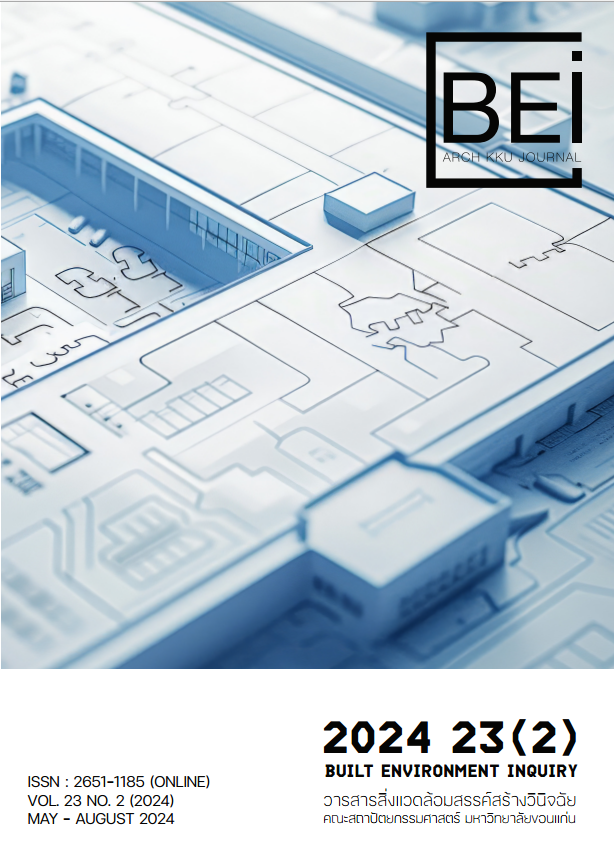การศึกษาพื้นที่ร่มเงาจากที่บังแดดแนวตั้งภายใต้ศาลาที่พักผู้โดยสารรถประจำทาง
DOI:
https://doi.org/10.14456/bei.2024.14คำสำคัญ:
ศาลาที่พักผู้โดยสาร, ที่บังแดดแนวตั้ง, พื้นที่ร่มเงา, การจำลองบทคัดย่อ
ศาลาที่พักผู้โดยสารรถประจำทาง เป็นจุดขึ้นลงรถและจุดพักระหว่างเดินทาง มีหลังคาเป็นที่บังแดดและให้ร่มเงา เนื่องจากการป้องกันรังสีอาทิตย์เป็นสิ่งจำเป็นในเขตภูมิอากาศร้อน ขณะที่ศาลาที่พักผู้โดยสารในปัจจุบันส่วนใหญ่มีเพียงหลังคาด้านบน หากติดตั้งที่บังแดดแนวตั้งด้านข้างจะช่วยให้สามารถบังแดดหรือเกิดพื้นที่ร่มเงาได้มากขึ้น การวิจัยนี้มีวัตถุประสงค์เพื่อคำนวณและเปรียบเทียบพื้นที่ร่มเงาจากที่บังแดดแนวตั้งในตำแหน่งต่าง ๆ ของศาลาที่พักผู้โดยสารรถประจำทางในกรุงเทพมหานคร เมื่อตั้งอยู่ใน 8 ทิศหลัก โดยใช้โปรแกรมคอมพิวเตอร์จำลองการเกิดเงาของศาลาตั้งแต่เวลา 8.00 - 16.00 น. ใน 4 วันสำคัญ รวม 36 ชั่วโมง ศึกษาตำแหน่งและขนาดที่บังแดดแนวตั้งแตกต่างกัน 3 กลุ่ม ทั้งหมด 8 รูปแบบ ผลการวิจัยพบว่าศาลาที่มีที่บังแดดแนวตั้งสามารถช่วยให้มีพื้นที่ร่มเงาเฉลี่ยเพิ่มขึ้นจากเดิมที่มีเฉพาะหลังคาด้านบน นอกจากนี้จำนวนชั่วโมงที่เกิดพื้นที่ร่มเงาเกินครึ่งของพื้นที่ใช้งานศาลาเพื่อให้ผู้ใช้บริการมีที่บังแดดขณะรอรถมีมากขึ้น โดยศาลาแต่ละรูปแบบที่หันไปในทิศที่แตกต่างกัน จะมีพื้นที่ร่มเงาเฉลี่ยรวมทั้งจำนวนชั่วโมงที่มีพื้นที่ร่มเงาเกินครึ่งต่างกัน โดยศาลาที่มีที่บังแดดแนวตั้งด้านหลังร่วมกับด้านมองรถและด้านข้าง (C3) จะมีพื้นที่ร่มเงาเฉลี่ยสูงที่สุด รองลงมาเป็นศาลารูปแบบที่มีที่บังแดดแนวตั้งด้านหลัง (A3) ผลการวิจัยนี้เป็นประโยชน์แก่ผู้เกี่ยวข้องในการออกแบบศาลาที่พักผู้โดยสารรถประจำทาง ซึ่งเป็นองค์ประกอบสำคัญในการรับรู้ของผู้ใช้งานต่อคุณภาพการให้บริการของรถสาธารณะ
เอกสารอ้างอิง
Amores, T. R. P., et al. (2023). Effect of green infrastructures supported by adaptative solar shading systems on livability in open spaces. Urban Forestry & Urban Greening, 82, 127886.
Bangkok Metropolitan Administration. (2021). Khumue Kan Patibatngan Samnakngan Rabop Khonsong Samnak Kan Charachon Lae Khonsong Phoso 2564. (In Thai) [Operating Manual, Transportation Office, Traffic and Transportation Department, B.E. 2564]. Retrieved March 1, 2022, from https://officialadmin.bangkok.go.th/public/upload_fm/ITA/O13/O13_22_4%20สำนักงานระบบขนส่ง.pdf
Chaiyakul, Y. (2008). Kan Wikhro Kan Bang Daet Lae Saeng Thammachat Doi Google SketchUp. (In Thai) [Google SketchUp for shading and daylighting analysis]. Retrieved May 15, 2022, from https://arch.kku.ac.th/pr/wp-content/uploads/2011/08/Abstract36.pdf
Dzyuban, Y., et al. (2022). Public transit infrastructure and heat perceptions in hot and dry climates. International journal of biometeorology, 66 (2), 345-356.
Emmanuel, R. (2016). Urban climate challenges in the tropics: rethinking planning and design opportunities. N.P.: World Scientific.
Kyropoulou, M. (2022). Shading Design for Outdoor Learning in Warm and Hot Climates Using Evolutionary Computation: A Case Study in Houston TX. In 2022 Annual Modeling and Simulation Conference (ANNSIM) (pp. 682-693). N.P.: IEEE.
Lachapelle, J. A., et al. (2023). Maximizing the pedestrian radiative cooling benefit per street tree. Landscape and Urban Planning, 230, 104608.
Leu, L., & Boonyaputthipong, C. (2023). A Study of Shading Devices in Modern Architecture for the Hot Humid Climate of Phnom Penh, Cambodia. Nakhara: Journal of Environmental Design and Planning, 22 (1), 301-301.
Lin, T. P., Matzarakis, A., & Huang, J. J. (2006). Thermal comfort and passive design strategy of bus shelters. Paper presented at 23rd International Conference on Passive and Low Energy Architecture, Geneva, Switzerland.
Lin, T. P., Matzarakis, A., & Hwang, R. L. (2010). Shading effect on long-term outdoor thermal comfort. Building and environment, 45 (1), 213-221.
London, M. O. (2017). Accessible Bus Stop Design Guidance. Retrieved December 1, 2021, from https://content.tfl.gov.uk/bus-stop-design-guidance.pdf
Marsh, A. J. (2014). 2D Sun-Path. Retrieved March 1, 2022, from https://drajmarsh.bitbucket.io/sun path2d.html
Peng, F., Xiong, Y., & Zou, B. (2021). Identifying the optimal travel path based on shading effect at pedestrian level in cool and hot climates. Urban Climate, 40, 100988.
Phongudomkul, S., Piriyasatta, P., & Thongkamsamut, Ch. (2021). Itthiphon Khong Rupbaep Thang Kaiyaphap Khong Upakon Bang Daet to Kha Samprasit Kan Bang Daet Khong Upakon Bang Daet Nai Prathet Thai. (In Thai) [An Influence of Physical Appearance of Shading Devices to Shading Coefficient in Thailand]. Built Environment Inquiry (BEI): Faculty of Architecture, Khon Kaen University, 20 (1), 49-61.
Shih, W. M., et al. (2017). Long-term perceptions of outdoor thermal environments in an elementary school in a hot-humid climate. International journal of biometeorology, 61, 1657-1666.
Wu, H., & Kriksic, F. (2012). Designing for pedestrian comfort in response to local climate. Journal of wind engineering and industrial aerodynamics, 104, 397-407.
Yamtraipat, N. (2006). Kan Chamlong Saphap Kan Koet Ngao Bon Natang Chak Upakon Bang Daet Chanit Naeonon Lae Naeotang Duai Khomphiotoe. (In Thai) [Computer simulation of shading profile on windows from overhang and fin shading devices]. Engineering and Applied Science Research, 33 (4), 391-402.
Yeang, K., et al. (2015). Design with Climate: Bioclimatic Approach to Architectural Regionalism-New and expanded Edition. N.P.: Princeton University Press.
ดาวน์โหลด
เผยแพร่แล้ว
รูปแบบการอ้างอิง
ฉบับ
ประเภทบทความ
สัญญาอนุญาต
ลิขสิทธิ์ (c) 2024 สิ่งแวดล้อมสรรค์สร้างวินิจฉัย

อนุญาตภายใต้เงื่อนไข Creative Commons Attribution-NonCommercial-NoDerivatives 4.0 International License.
ทัศนะและข้อคิดเห็นของบทความที่ปรากฏในวารสารฉบับนี้เป็นของผู้เขียนแต่ละท่าน ไม่ถือว่าเป็นทัศนะและความรับผิดชอบของกองบรรณาธิการ




